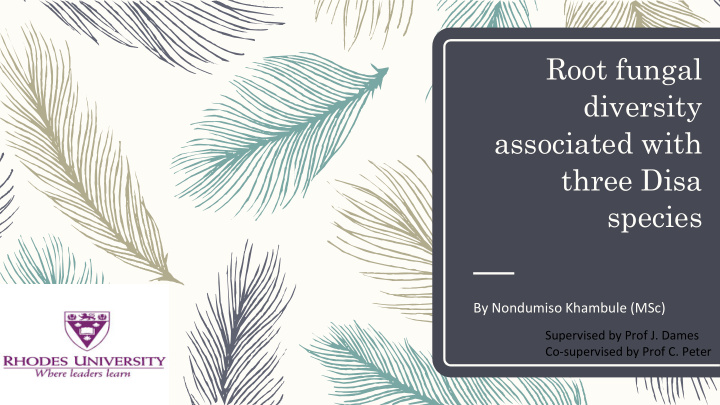



Root fungal diversity associated with three Disa species By Nondumiso Khambule (MSc) Supervised by Prof J. Dames Co-supervised by Prof C. Peter
Introduction – Orchid mycorrhizas are mutualistic interactions between fungi and members of the Orchidaceae (Dearnaley 2007) – Orchids have ‘dust seeds’, that are very small (0.3-14 µg) consisting of minute embryos that lack endosperm and have few reserves (Burgeff 1936; Arditti & Ghani 2000) – The presence of fungi assist in germination of seeds (Tsutsui & Tomita 1986; Clements 1988; Rasmussen et al 2009) – Orchids are highly depended on the provision of nutrients by mycorrhizal fungi during early seedling development (Smith & Read 2008) – In adult orchids, the mycorrhizal associations are important for mineral nutrition (Gebaur and Meyer 2003; Smith & Read 2008; Brundrett 2009) – Orchid mycorrhizal (OM) research in South Africa has received little attention
Aims and Objectives D. bracteata Objective: – To identify the mycorrhizal fungi interacting with Disa bracteata , D. cornuta and D. polygonoides D.cornuta Aims: – Confirm mycorrhizal colonization of roots – Isolate and identify associated root fungi (culture dependent approach) – Assess root fungal biodiversity using culture independent approach D.polygonoides
Mycorrhizal colonization – Roots were cleared and stained, observed microscopically using light microscope (Kristiansen et al 2004) – Mycorrhizas produce intracellular coils called pelotons within roots cells (Smith and Read 2008) – All three Disa species were colonized by mycorrhizal fungi Peloton
Fungal isolates – Root pieces were surface sterilized and plated on various media – Single fungal colonies were sub-cultured and molecular identified PCR was conducted using ITS1F and ITS4 primers (Gardes and Bruns 1993) – – Purified PCR products were sent for Sanger sequencing – Sequence comparisons using GenBank database (https://www.ncbi.nlm.nih.gov/Genomes/index.html)
Fungal Isolates Oidiodendron sp. 99% Penicillium sp. 99%/ Trichoderma sp. 100%/ Talaromyces Chaetomium / 99%/ 0.0 aureum strain 100 98%/ 0.0 93%/ 0.0 radicus 96%/ 98%/ 0.0 %/96%/0.0
Diversity – Roots were surface sterilized and stored in RNA later – DNA was extracted , PCR was conducted using ITS1F and ITS4 primers (Gardes and Bruns 1993) Purified PCR products were cloned using pGEM T-Easy Vector – – Plasmids were sent for Sanger sequencing – Sequences were aligned and submitted for comparison to GenBank ( https://www.ncbi.nlm.nih.gov/Genomes/index.html) And UNITE (https://unite.ut.ee/analysis.php)
Diversity Orchid species Clones Description Query cover in Percentage (%) E-value Accession Number Percentage (%) Identification Disa cornuta DC1 Epicoccum nigrum 93% 99% 0.0 MH290364.1 DC2 Tulasnella sp. 78% 96% 0.0 JX514389.1 DC3 Fungal sp. strain 91% 99% 0.0 KU839098.1 DC4 Helotiales sp. 88% 100% 0.0 KX440158.1 DC5 Uncultured fungus 89% 98% 0.0 KT957785.1 Disa polygoniodes DP1 Terfezia boudieri 29% 100% 2e-79 LT718229.1 DP2 Uncultured fungus 93% 99% 0.0 HQ850140.1 DP3 Uncultured Ascomycota 92% 95% 0.0 JX998699.1 DP4 Tulasnella calospora 92% 98% 0.0 GU166421.1 DP5 Uncultured Helotiales 92% 99% 0.0 JX317118.1 Disa brecteata DB1 Sordariales sp. 89% 99% 3e-130 KY228640.1 DB3 Uncultured ectomycorrhizal fungus 71% 80% 8e-74 FR731633.1 DB4 Uncultured Agaricales 91% 99% 0.0 FJ553698.1 DB5 Uncultured fungus 92% 99% 0.0 LC271287.1
Conclusion – D. polygonoides and D. cornuta are associated with Tulasnella (Basidiomycota) a known orchid mycorrhizal fungus – D. brecteata associates could not be sufficiently identified, but further cloning is being done using more orchid specific primers – Oidiodendron sp . Isolated from roots is a known ericoid mycorrhizal fungus (Ascomycota) and may be associating with orchids, this requires further investigation.
References
Acknowledgments – Colleagues from Mycorrhizae Research group – NRF – NRF-FBIP small grant funding (Prof Dames)
Thank you
Recommend
More recommend